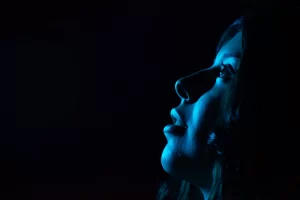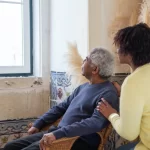Blue Light and Sleep: What Nurses Need to Know
 Strategic interventions can improve alertness and sleep.
Strategic interventions can improve alertness and sleep.
Takeaways
- Sleep is a key component of a healthy lifestyle.
- Bright or blue light exposure before bedtime can disrupt biological sleep mechanisms, making it more challenging for nurses to obtain adequate sleep.
- Nurses may be able to improve sleep by blocking or exposing themselves to daylight and/or blue light at key times of the day.
Healthy sleep holds as much significance as diet and exercise to optimal health and wellbeing. Poor or insufficient sleep has been associated with increased risk for motor vehicle accidents, work injuries, diabetes, heart disease, cancer, depression, and other mental health disorders. Many shift workers, including nurses, experience difficulty obtaining enough good sleep because they work nights or have early morning start times. In a meta-analysis by Zeng and colleagues, over half of nurses studied report that they experience poor sleep quality. According to Hittle and colleagues, on average, nurses report sleeping a little less than 6.5 hours per day, less than the 7 to 9 hours of sleep recommended daily. Although a 30-minute difference may not seem like much, over time it can add up, jeopardizing health and safety.
Our bodies are biologically designed to be awake during daylight hours and asleep when it’s dark. Sunlight (a blue light source), acts as an external signal to the body that it should be awake. Staying alert when it’s dark outside or obtaining sufficient quality and quantity of sleep during the day can be challenging. Exposure to blue light sources (such as bright indoor lighting and electronics) before bedtime can exacerbate sleep problems.
Sleep and circadian systems at a glance
Natural wake and sleep times can be explained by the two-process sleep regulation model: homeostatic sleep pressure and the circadian system. Homeostatic sleep pressure refers to the need to sleep, which begins building in the body the moment we wake up, so by the end of the day we feel ready to sleep. The circadian system is controlled by the suprachiasmatic nucleus (SCN), located in the hypothalamus. The SCN, also called the master clock or “conductor” of the circadian system, paces the timing of all the body’s circadian rhythms and physiologic functions such as the sleep–wake cycle. The SCN relies on external cues (such as light) and internal cues (such as the time of day meals are consumed) to keep the clock on schedule and aligned with our day–night earth cycle.
Light is one of the strongest external signals keeping the circadian system in time with the 24-hour period. Although several light properties can affect the circadian system, wavelength is the most significant. “Blue light” refers to shorter wavelengths in the light spectrum and are stronger influencers on the circadian system than red or orange light (longer wavelengths). Daylight, bright indoor lights, and light from electronic devices all contain blue light. When we’re exposed blue light sources, the retina detects the short wavelengths and sends a signal to the SCN that it’s daytime. As a result, the SCN turns off the circadian system’s nighttime physiologic functions and turns on daytime functions. For example, circadian rhythms regulate the hunger and satiety hormones ghrelin and leptin, which circulate more widely during the day to accommodate our response to food. Likewise, in the evening, the decrease in natural sunlight signals the SCN to release melatonin, easing the body to sleep.
Because our circadian system is more sensitive to bright light at night, shift workers may experience suppressed melatonin production, making it difficult for them to sleep. Regular exposure to light at night also can shift circadian timing, resulting in a delayed sleep phase (pushing sleep timing later than our bodies would naturally fall asleep) and contributing to a misalignment of our circadian system with the day–night earth light cycle. Circadian misalignment and exposure to light at night also have been implicated in disease development, including cardiometabolic disease and certain cancers. Delayed sleep phase can occur in those exposed to bright light before falling asleep at night or night shift nurses exposed to daylight while trying to sleep during the day.
Light exposure and research
Indoor lighting and common technologies (computers, e-readers, smart phones) have changed the way we work and live. Before the invention of the lightbulb, sleep and work times were largely dictated by the rising and setting of the sun. Electricity and indoor lighting gave us more control over our sleep timing, no longer strictly waking and sleeping by daylight hours. Computers and other digital technology provide expanded access to entertainment, shopping, socializing, and work tasks dominated by lighted screens. We find ourselves in a 24/7 society, where we spend more time indoors during the day and are awake later at night. Regardless of what shift we work, we’re exposed to less natural daylight and more indoor light (including blue light) than previous generations.
Industrial lighting, including the LED and fluorescent frequently found in hospitals, can simulate sunlight, tricking our SCN into thinking it’s daytime. If light exposure can increase alertness and disrupt sleep, can we time it to our advantage while at work or in-between shifts? The short answer is maybe. In a laboratory study by Kervezee and colleagues, participants exposed to bright light treatment during an 8-hour simulated night shift experienced a change in their sleep, indicating some adaptation to the night shift schedule.
Harrison and collaborators conducted a small multimodal light intervention study within a hospital setting. The intervention included installing brighter lighting in the nurses’ station, limited exposure to a bright light box when tired, blue light-blocking glasses to wear before sleep, and eye masks to wear during sleep. Nurses reported enhanced alertness while working, improved sleep quality, and a better overall quality of life.
Other studies have focused specifically on blocking blue light at strategic times of the day with blue light–blocking glasses. Two small studies of night shift workers wearing the glasses during the day showed increased daytime sleep duration, decreased sleep disruption, and improved circadian adaptation to night shift work (as measured by melatonin levels). This research may point us toward interventions where timing and exposure to bright light help nurses better adapt to night shift and early shift work and strategically blocking blue light helps improve sleep.
Although exposure and timing of bright light is of particular importance to night shift nurses, all nurses could benefit from awareness of the risks related to blue light exposure from smart phones, TVs, and other electronics before bedtime. This exposure can trigger the SCN to activate daytime circadian functions, increasing alertness and decreasing sleepiness. Technology companies have tried to overcome this effect by installing orange light “night mode” features on devices. Unfortunately, a recent study by Mason and colleagues, using randomly assigned control and intervention groups, didn’t find significant improvement in sleep when using night mode.
Be strategic
Research into strategic light use in the workplace continues to evolve. We continue to learn about sleep, light exposure, and associated health mechanisms. A recent literature review by Lowden and colleagues highlighted five lighting factors that should be considered before implementing workplace lighting changes: light wavelength or spectrum, light intensity, duration of light exposure, time of day light exposure occurs, and light exposure experienced earlier in the day. Little knowledge exists about the correct dosage (duration, intensity) of these various light components, and we have limited consensus on how light exposure should be measured and the most salient outcomes. Because of these variabilities and too few longitudinal studies, little guidance is available on how to integrate lighting interventions in the workplace. Hospitals and other healthcare organizations should strategize how and where to implement lighting changes. Brighter light may help boost night shift nurses’ alertness, but it also could disrupt patients’ sleep.
Beverly M. Hittle is an assistant professor at the University of Cincinnati College of Nursing in Cincinnati, Ohio. Imelda Wong is the coordinator for the Center for Work and Fatigue Research and an occupational hygienist and epidemiologist at the Centers for Disease Control and Prevention National Institute for Occupational Safety and Health in Cincinnati.
Editor’s note: The findings and conclusions in this report are those of the authors and do not necessarily represent the official position of the National Institute for Occupational Safety and Health, Centers for Disease Control and Prevention.
Authors: Beverly M. Hittle, PhD, RN, and Imelda Wong, PhD
References
Boivin DB, Boudreau P, Tremblay GM. Phototherapy and orange-tinted goggles for night-shift adaptation of police officers on patrol. Chronobiol Int. 2012;29(5):629-40. doi:10.3109/07420528.2012.675252
Borbély AA, Daan S, Wirz-Justice A, Deboer T. The two-process model of sleep regulation: A reappraisal. J Sleep Res. 2016;25(2):131-43. doi:10.1111/jsr.12371.
Caruso CC, Geiger-Brown J, Takahashi M, Trinkoff A, Nakata A. Cincinnati, OH: US Department of Health and Human Services, Centers for Disease Control and Prevention, National Institute for Occupational Safety and Health, DHHS (NIOSH) Publication No. 2015-115 (Revised 10/2021).
Duraccio KM, Zaugg KK, Blackburn RC, Jensen CD. Does iPhone night shift mitigate negative effects of smartphone use on sleep outcomes in emerging adults? Sleep Health. 2021;7(4):748-84. doi:10.1016/j.sleh.2021.03.005
Harrison EM, Schmied EA, Easterling AP, Yablonsky AM, Glickman GL. A hybrid effectiveness-implementation study of a multi-component lighting intervention for hospital shift workers. Int J Environ Res Public Health. 2020;17(23):9141. doi:10.3390/ijerph17239141
Hittle BM, Caruso CC, Jones HJ, Bhattacharya A, Lambert J, Gillespie GL. Nurse health: The influence of chronotype and shift timing. West J Nurs Res. 2020;42(12):1031-141. doi:10.1177/0193945920916802
Kervezee L, Cuesta M, Cermakian N, Boivin DB. The phase-shifting effect of bright light exposure on circadian rhythmicity in the human transcriptome. J Biol Rhythms. 2019;34(1):84-97. doi:10.1177/0748730418821776
Lowden A, Öztürk G, Reynolds A, Bjorvatn B. Working Time Society consensus statements: Evidence based interventions using light to improve circadian adaptation to working hours. Ind Health. 2019;57(2):213-27. doi:10.2486/indhealth.SW-9
Mason IC, Boubekri M, Figueiro MG, et al. Circadian health and light: A report on the National Heart, Lung, and Blood Institute’s workshop. J Biol Rhythms. 2018;33(5):451-7. doi:10.1177/0748730418789506
Sasseville A, Benhaberou-Brun D, Fontaine C, Charon M-C, Hebert M. Wearing blue-blockers in the morning could improve sleep of workers on a permanent night schedule: A pilot study. Chronobiol Int. 2009;26(5):913-25. doi:10.1080/07420520903044398
Vetter C, Phillips AJK, Silva A, Lockley SW, Glickman G. Light me up? Why, when, and how much light we need. J Biol Rhythms. 2019;34(6):573-5. doi:10.1177/0748730419892111
Watson NF, Badr MS, Belenky G, et al. Joint Consensus Statement of the American Academy of Sleep Medicine and Sleep Research Society on the Recommended Amount of Sleep for a Healthy Adult: Methodology and discussion. Sleep. 2015;38(8):1161-83.doi:10.5665/sleep.4886
Zeng LN, Yang Y, Wang C, et al. Prevalence of poor sleep quality in nursing staff: A meta-analysis of observational studies. Behav Sleep Med. 2020;18(6):746-59. doi:10.1080/15402002.2019.1677233
(This story originally appeared on My American Nurse.)




